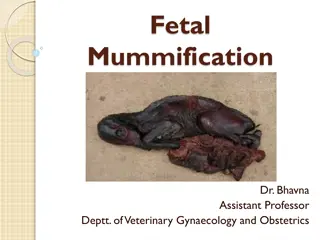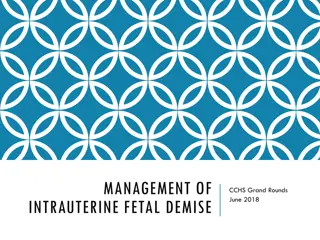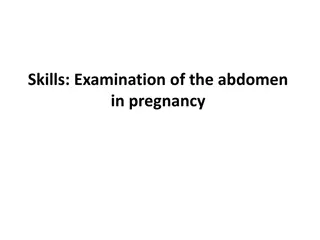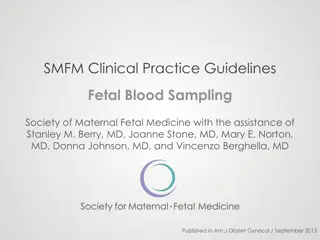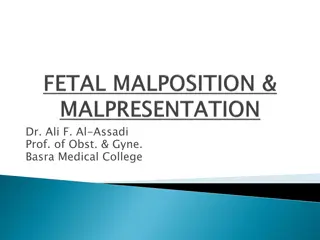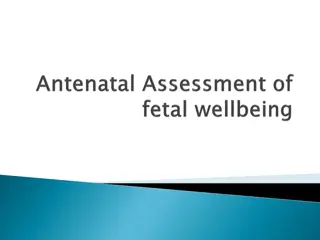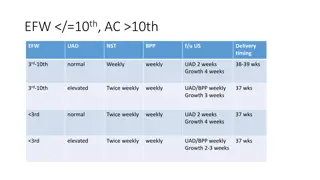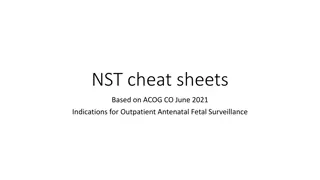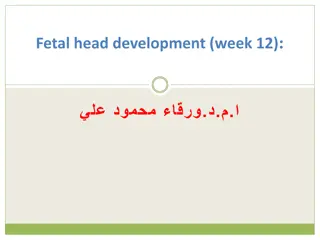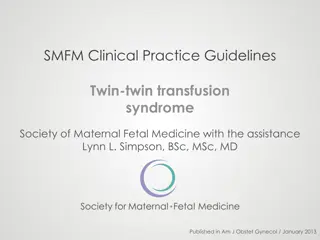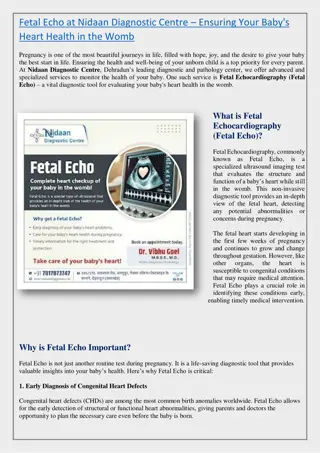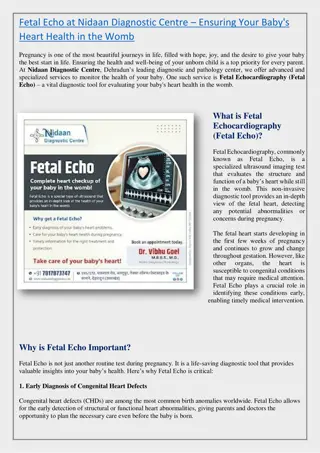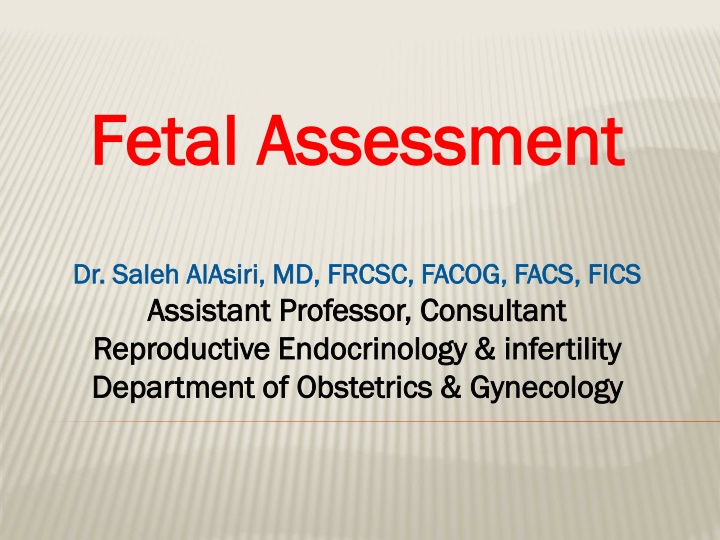
Fetal Assessment: Methods, Rationale, and Importance
Explore the various aspects of fetal assessment including early and late pregnancy evaluations, techniques like fetal heart auscultation and movement counting, and the rationale behind assessing fetal oxygenation. Learn how these assessments help identify and prevent neurological injuries or complications in fetuses. Key points include when and how to conduct assessments, what they involve, and their significance in ensuring fetal well-being throughout pregnancy.
Download Presentation

Please find below an Image/Link to download the presentation.
The content on the website is provided AS IS for your information and personal use only. It may not be sold, licensed, or shared on other websites without obtaining consent from the author. If you encounter any issues during the download, it is possible that the publisher has removed the file from their server.
You are allowed to download the files provided on this website for personal or commercial use, subject to the condition that they are used lawfully. All files are the property of their respective owners.
The content on the website is provided AS IS for your information and personal use only. It may not be sold, licensed, or shared on other websites without obtaining consent from the author.
E N D
Presentation Transcript
Fetal Assessment Fetal Assessment Dr. Dr. Saleh AlAsiri, Saleh AlAsiri, MD, Assistant Professor, Assistant Professor, Consultant Reproductive Endocrinology & Reproductive Endocrinology & infertility Department of Obstetrics & Department of Obstetrics & Gynecology MD, FRCSC, FRCSC, FACOG, FACOG, FACS, Consultant infertility Gynecology FACS, FICS FICS
FETAL ASSESSMENT FETAL ASSESSMENT to identify fetuses at risk of neurologic injury or death in order toprevent it It can be divided into: A-Early Early pregnancy fetal assessment B-Late Late pregnancy fetal assessment
RATIONALE fetal oxygenation challenged: - blood flow directed to brain, heart & adrenal & blood flow away from the kidney fetal urine production AF volume. - CNS hypoxia Fetal movement - Chemoreceptor's vagually-mediated reflex Fetal heart rate abnormality late deceleration. decrease
EARLY PREGNANCY ASSESSMENT Fetal heart activity Fetal heart activity fetal auscultation (fetal doppler device, doptone) ~12weeks
fetal heart activity seen by USS Can be seen from 6 6 weeks weeks
EARLY PREGNANCY ASSESSMENT Fetal movement Fetal movement Fetal movement are usually first perceptible to mother ~17w-20w (quickening) 50% of isolated limb movements are perceived 80% of trunk and limb movements Fetal growth Fetal growth Symphysis fundal height (SFH) Ultrasound
2- LATE PREGNANCY ASSESSMENT Fetal movement counting (kick chart) Contraction Stress Test (CST) Non stress test (NST) Doppler Velocimetry (UAV) Amniotic fluid index (AFI)
FETAL MOVEMENT COUNTING FETAL MOVEMENT COUNTING It should be started ~ It should be started ~28 &~ &~24 24w in high risk pregnancy w in high risk pregnancy It can reduce avoidable stillbirth It can reduce avoidable stillbirth 28w in normal pregnancy w in normal pregnancy CARDIFF TECHNIQUE CARDIFF TECHNIQUE - -10 10 movement in movement in 12 - -If abnormal If abnormal 12 hours hours further assessment further assessment
CONTRACTION STRESS TEST (CST) Causing uterine contraction over 20 At least 2 2 uterine contractions uterine contractions Uterine contraction restrict O2 delivery to the fetus Normal Normal fetus will tolerate contraction Hypoxic Hypoxic fetus will have late deceleration 20 minutes minutes late deceleration
NON STRESS TEST (NST) Main advantage over CST is no need for contraction
NON STRESS TEST NON STRESS TEST The baseline 120 Different criteria in fetuses <32w A A- - Reactive Reactive: At least 2 2 accelerations from base line of 15 for at least 15 15 sec sec within 20 B B- - Non Reactive Non Reactive: No acceleration after 20 minutes another 20 minutes 120- -160 160 beats/minute 15 bpm bpm 20 minutes minutes
NON STRESS TEST ( NON STRESS TEST (NST) NST) If non- reactive in 40 stress test or Biophysical Profile (BPP) 40 minutes Contraction
AMNIOTIC FLUID VOLUME (AFI) Amniotic Fluid Index (AFI) Amniotic Fluid Index (AFI) - the sum of the maximum vertical fluid pocket diameter in 4 quarters - Normal value 5 5- -25 25cm cm -<5 : oligohydraminous oligohydraminous ->25 : polyhydraminous polyhydraminous
BIOPHYSICAL PROFILE (BPP) Combines NST , AFV, fetal breathing, body movement & tone. it is a scoring system ( out of 10 it is done over 30 30 min It measures - Acute hypoxia (NST, body mov. & breathing) - Chronic hypoxia (AFI) 10 points)
FETAL BIOPHYSICAL PROFILE/NST+ Normal (score=2) Biophysical Variable 1 episode FBM of at least 30 s duration in 30 min movements Abnormal (score= 0) Absent FBM or no episode >30 s in 30 min 2 or fewer body/limb movements in 30 min Fetal breathing 3 discrete body/limb movements in 30 min Fetal movements 1 episode of active extension with return to flexion of fetal limb(s) or trunk. Opening and closing of the hand considered normal tone Either slow extension with return to partial flexion or movement of limb in full extension Absent fetal movement Either no AF pockets or a pocket<2 cm in 2 perpendicular planes Fetal tone 1 pocket of AF that measures at least 2 cm in 2 perpendicular planes Amniotic fluid volume
BPP The risk of fetal death within 1 week if BPP is normal~ 1/1300
DOPPLER VELOCIMETRY Measurement of blood flow velocities in maternal & fetal vessels Reflects feto-placental circulation Doppler indices from Uterine Artery cerebral artery cerebral artery (MCA) In IUGR : absent or reversed EDF (end diastolic flow) : associated with fetal hypoxia Uterine Artery & Middle Middle
II- INVASIVE FETAL ASSESSMENT 1 1- - Amniocentesis Amniocentesis
1- AMNIOCENTESIS Obtaining a sample of amniotic fluid during Obtaining a sample of amniotic fluid during pregnancy. pregnancy. Usullay done after Usullay done after 15 15 w Indications: Indications: -Genetic (karyotype) Genetic (karyotype) - -Billirubin level : (RH Billirubin level : (RH- -isoimunisation) isoimunisation) - -Fetal lung maturity : (L / S) ratio Fetal lung maturity : (L / S) ratio - -Therapeutic : Polyhydramnios Therapeutic : Polyhydramnios Risks Risks: : ROM ROM ~ ~1 1% , % , abortion abortion 0.5 w 0.5% , % , infection infection 1 1/ /1000 1000
2- CHORIONIC VILLUS SAMPLING (CVS): Usually done after It is the procedure of choice for first trimester prenatal diagnosis of genetic disorders Complications Complications: fetal loss fetal loss (0.7 within within 30 30 days) days), , Procedure-induced limb defects after 10 10w w first trimester 0.7 % within % within 14 14 days and days and 1.3 limb defects 1.3 % % .
3- CORDOCENTESIS Indications Indications: - Rapid karyotyping - Diagnosis of inherited disorders - Fetal Hb assessment - Fetal platelets level - Fetal blood transfusion Complications Complications: bleeding, bradycardia, infection.





